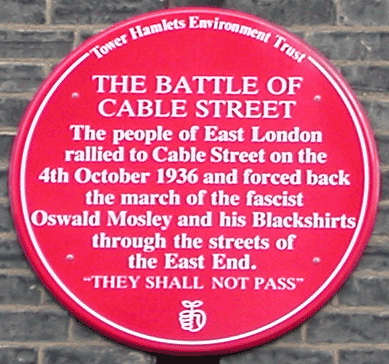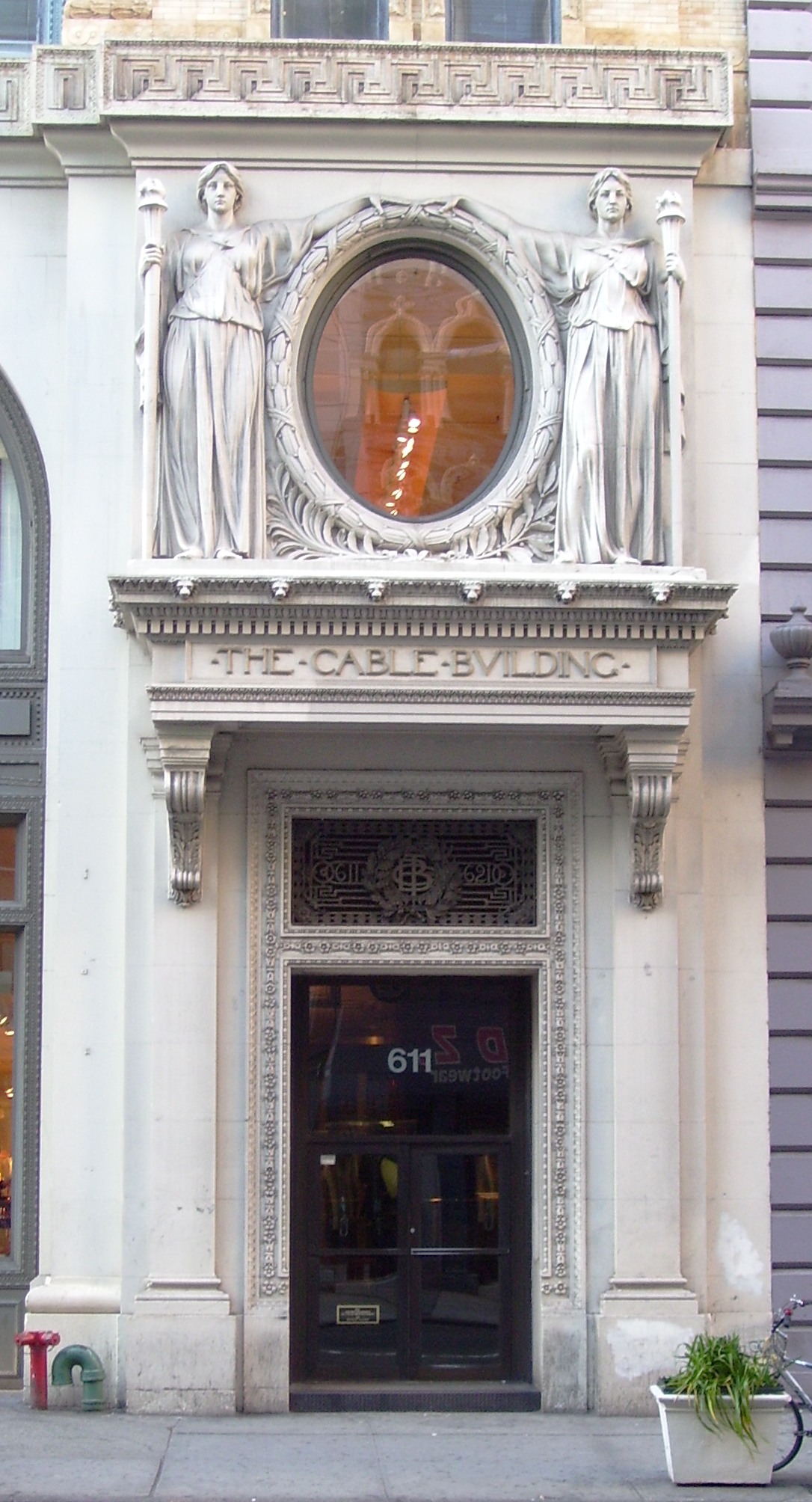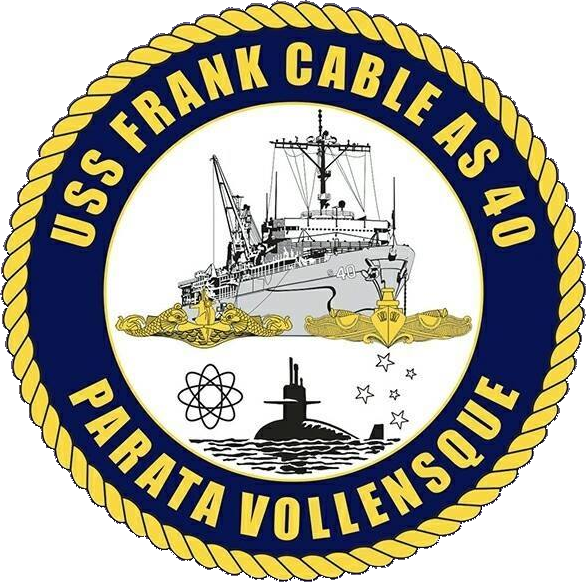|
Cable
Cable may refer to: Mechanical * Nautical cable, an assembly of three or more ropes woven against the weave of the ropes, rendering it virtually waterproof * Wire rope, a type of rope that consists of several strands of metal wire laid into a helix ** Arresting cable, part of a system used to rapidly decelerate an aircraft as it lands ** Bowden cable, a mechanical cable for transmitting forces * Rope generally, especially a thick, heavy ("cable laid") variety Transmission * Electrical cable, an assembly of one or more wires which may be insulated, used for transmission of electrical power or signals ** Coaxial cable, an electrical cable comprising an inner conductor surrounded by a flexible, tubular insulating layer, coated or surrounded by a tubular conducting shield ** Power cable, a cable used to transmit electrical power ** Submarine communications cable, a cable laid on the sea bed to carry telecommunication signals between land-based stations * Fiber-optic cable, a cable co ... [...More Info...] [...Related Items...] OR: [Wikipedia] [Google] [Baidu] |
Cable (character)
Cable (Nathan Christopher Charles Summers) is a fictional character appearing in American comic books published by Marvel Comics, commonly in association with X-Force and the X-Men. The child Nathan first appeared as a newborn infant in ''The Uncanny X-Men'' #201 (Jan. 1986) created by writer Chris Claremont and penciler Rick Leonardi, while the adult warrior Cable was created by writer Louise Simonson and artist/co-writer Rob Liefeld, and first appeared in ''The New Mutants'' #87 (March 1990). Initially, Cable's origin was undecided and he was assumed to be a separate character. It was later decided that he was actually an older version of the child Nathan, having later become a time traveler. Nathan Summers is the son of the X-Men member Cyclops (Scott Summers) and his first wife Madelyne Pryor (Jean Grey's clone). This makes him the "half"-brother of Rachel Summers (a child of Scott and Jean from the "Days of Future Past" timeline) and Nate Grey (a child created from Scott a ... [...More Info...] [...Related Items...] OR: [Wikipedia] [Google] [Baidu] |
Cable (comic Book)
''Cable'' is the name of multiple comic book titles featuring the character Cable and published by Marvel Comics, beginning with the original ''Cable'' comic book series which debuted in 1993. Publication history In 1992, the character was featured in his first solo series, a two issue miniseries, titled ''Cable: Blood and Metal'', written by Fabian Nicieza, pencilled by John Romita, Jr., and inked by Dan Green, published in October and November of that year. Volume 1 Shortly after ''Blood and Metal'', Cable was given his own ongoing series titled ''Cable''. The book initially had trouble finding a stable creative team. A writer/penciller team would complete no more than three issues in a row until Jeph Loeb and Ian Churchill began work on issue #20 and finish on #35 (though with a gap between issues #20 and #21 due to the Age of Apocalypse event). Loeb and Churchill provided the first instance of stability, working together on 15 of the 20 issues from #20–39. During their run ... [...More Info...] [...Related Items...] OR: [Wikipedia] [Google] [Baidu] |
Submarine Communications Cable
A submarine communications cable is a cable laid on the sea bed between land-based stations to carry telecommunication signals across stretches of ocean and sea. The first submarine communications cables laid beginning in the 1850s carried telegraphy traffic, establishing the first instant telecommunications links between continents, such as the first transatlantic telegraph cable which became operational on 16 August 1858. Subsequent generations of cables carried telephone traffic, then data communications traffic. Modern cables use optical fibre technology to carry digital data, which includes telephone, Internet and private data traffic. Modern cables are typically about in diameter and weigh around for the deep-sea sections which comprise the majority of the run, although larger and heavier cables are used for shallow-water sections near shore. Submarine cables first connected all the world's continents (except Antarctica) when Java was connected to Darwin, Northern Terr ... [...More Info...] [...Related Items...] OR: [Wikipedia] [Google] [Baidu] |
Cable Street
Cable Street is a road in the East End of London, England, with several historic landmarks nearby. It was made famous by the Battle of Cable Street in 1936. Location Cable Street starts near the edge of London's financial district, the City of London, in south-western Whitechapel and continues on through to central Shadwell and then to south-eastern Stepney, to the junction between Cable Street and Butcher Row in Limehouse. The street is parallel to, and south of, the Docklands Light Railway and Commercial Road, and north of The Highway. The area is close to Wapping and Shadwell Basin to the south, Tower Hill to the west, and Aldgate to the north. Since many Londoners define their locality by the nearest London Underground stations, the Cable Street area is often referred to as Shadwell. The street is in the London Borough of Tower Hamlets, in postal district E1. It lies within the parliamentary constituencies of Bethnal Green and Bow and Poplar and Limehouse, currently re ... [...More Info...] [...Related Items...] OR: [Wikipedia] [Google] [Baidu] |
Cable Building (New York City)
The Cable Building is located at 611 Broadway (Manhattan), Broadway at the northwest corner with Houston Street in NoHo, Manhattan, NoHo and Greenwich Village, in Manhattan, New York City. Since it spans a block, the Cable Building also has addresses of 2-18 West Houston Street and 178-188 Mercer Street (Manhattan), Mercer Street. Construction and design The Cable Building was built in 1892–1894. It is a steel and iron frame structure with brick, stone, and terra-cotta facing. It has a limestone base with a two-story arcade featuring show windows graced by iron spandrels and elegant keystones. It also has a prominent copper cornice with lions' faces, egg-and-dart moldings, and surmounting acanthus. It is believed to be the architectural firm McKim, Mead & White's first use of a complete steel frame in a commercial building. In an article published on May 7, 1892 under the heading of "The Beginning of the Transformation of Broadway", the publication of record for New York re ... [...More Info...] [...Related Items...] OR: [Wikipedia] [Google] [Baidu] |
Coaxial Cable
Coaxial cable, or coax (pronounced ) is a type of electrical cable consisting of an inner conductor surrounded by a concentric conducting shield, with the two separated by a dielectric ( insulating material); many coaxial cables also have a protective outer sheath or jacket. The term ''coaxial'' refers to the inner conductor and the outer shield sharing a geometric axis. Coaxial cable is a type of transmission line, used to carry high-frequency electrical signals with low losses. It is used in such applications as telephone trunk lines, broadband internet networking cables, high-speed computer data busses, cable television signals, and connecting radio transmitters and receivers to their antennas. It differs from other shielded cables because the dimensions of the cable and connectors are controlled to give a precise, constant conductor spacing, which is needed for it to function efficiently as a transmission line. Coaxial cable was used in the first (1858) and followin ... [...More Info...] [...Related Items...] OR: [Wikipedia] [Google] [Baidu] |
USS Frank Cable (AS-40)
USS ''Frank Cable'' (AS-40) is the second built by the Lockheed Shipbuilding and Construction Company of Seattle, Washington for the United States Navy. The ship was christened on 14 January 1978 by Mrs. Rose A. Michaelis, wife of Admiral Frederick H. Michaelis, then Chief of Naval Material. The ship is named for Frank Cable, an electrical engineer who had worked as an electrician and trial captain for . History USS ''Frank Cable'' was designed as a submarine tender for s. The ship spent 1980 until 1996 as the repair ship for SUBRON 4 and 18 in Charleston, South Carolina, tending and s. ''Frank Cable'' began decommissioning in 1996, but then was reactivated and refitted to replace in the Western Pacific as Commander Seventh Fleet's mobile repair and support platform. Since arriving in Guam, USS ''Frank Cable'' has visited many Western Pacific ports to support U.S. military forces. In 1997, the ship was heavily involved with the rescue and recovery efforts following ... [...More Info...] [...Related Items...] OR: [Wikipedia] [Google] [Baidu] |
Cable (British Band)
Cable were an English indie rock band originally from Derby, who released three studio albums: ''Down-Lift the Up-Trodden'' (1996), ''When Animals Attack'' (1997) and ''Sub-Lingual'' (1999) on Infectious Records. The band split up in 1999, before briefly reforming in 2012. Career 1992-94 - Formation and early career Formed in 1992 by Matt Bagguley and Darius Hinks while attending the University of Derby, Bagguley and Hincks had first met whilst studying Graphic Design at North Warwickshire College of Technology and Art, Nuneaton. Cable were initially inspired by the art-rock leanings of indie labels including Touch and Go, Dischord, Blast First, Southern Records and Shimmy Disc, as well as UK artists such as Spacemen 3 and My Bloody Valentine. The first settled lineup was Matt Bagguley (vocals/guitar), Darius Hinks (guitar), Pete Darrington (bass) and Neil Cooper (drums). Throughout 1993 the band played regularly with underground acts from the US (including Medicine, ... [...More Info...] [...Related Items...] OR: [Wikipedia] [Google] [Baidu] |
Cable Television
Cable television is a system of delivering television programming to consumers via radio frequency (RF) signals transmitted through coaxial cables, or in more recent systems, light pulses through fibre-optic cables. This contrasts with broadcast television (also known as terrestrial television), in which the television signal is transmitted over-the-air by radio waves and received by a television antenna attached to the television; or satellite television, in which the television signal is transmitted over-the-air by radio waves from a communications satellite orbiting the Earth, and received by a satellite dish antenna on the roof. FM radio programming, high-speed Internet, telephone services, and similar non-television services may also be provided through these cables. Analog television was standard in the 20th century, but since the 2000s, cable systems have been upgraded to digital cable operation. A "cable channel" (sometimes known as a "cable network") is a tele ... [...More Info...] [...Related Items...] OR: [Wikipedia] [Google] [Baidu] |
The Cables
The Cables are a Jamaican rocksteady/reggae vocal trio led by Keble Drummond, who recorded for Studio One in the late 1960s. History The group was led by Keble Drummond (sometimes spelled Keeble), whose first name led to the name of the group.Peter I (2004)Interview With The Cables, ''Reggae Vibes'' Drummond explained "Now, I look at something with a cable and wires, and I say, well, 'Cables' would be a good name because you could send a message across the world, and that's how I came up with the name". He was backed by harmony singers Elbert Stewart (baritone) and Vince Stoddart (tenor).Larkin, Colin (1998) "The Virgin Encyclopedia of Reggae", Virgin Books, Drummond was taught the basics of guitar by Peter Austin of The Clarendonians and write his first songs after attending a songwriting course. Drummond had previously been a member of The Sylastians, along with Barry Llewellyn and Earl Morgan of The Heptones, and Clive Campbell of The Aces, and the Cables were first formed i ... [...More Info...] [...Related Items...] OR: [Wikipedia] [Google] [Baidu] |
Electrical Cable
An electrical cable is an assembly of one or more wires running side by side or bundled, which is used to carry electric current. One or more electrical cables and their corresponding connectors may be formed into a ''cable assembly'', which is not necessarily suitable for connecting two devices but can be a partial product (e.g. to be soldered onto a printed circuit board with a connector mounted to the housing). Cable assemblies can also take the form of a cable tree or cable harness, used to connect many terminals together. Etymology The original meaning of ''cable'' in the electrical wiring sense was for submarine telegraph cables that were armoured with iron or steel wires. Early attempts to lay submarine cables without armouring failed because they were too easily damaged. The armouring in these early days (mid-19th century) was implemented in separate factories to the factories making the cable cores. These companies were specialists in manufacturing wire rope of ... [...More Info...] [...Related Items...] OR: [Wikipedia] [Google] [Baidu] |
Fiber-optic Cable
A fiber-optic cable, also known as an optical-fiber cable, is an assembly similar to an electrical cable, but containing one or more optical fibers that are used to carry light. The optical fiber elements are typically individually coated with plastic layers and contained in a protective tube suitable for the environment where the cable is used. Different types of cable are used for different applications, for example, long distance telecommunication, or providing a high-speed data connection between different parts of a building. Design Optical fiber consists of a core and a cladding layer, selected for total internal reflection due to the difference in the refractive index between the two. In practical fibers, the cladding is usually coated with a layer of acrylate polymer or polyimide. This coating protects the fiber from damage but does not contribute to its optical waveguide properties. Individual coated fibers (or fibers formed into ribbons or bundles) then have a tough ... [...More Info...] [...Related Items...] OR: [Wikipedia] [Google] [Baidu] |






